Recipe for Economic Development Success Part 3
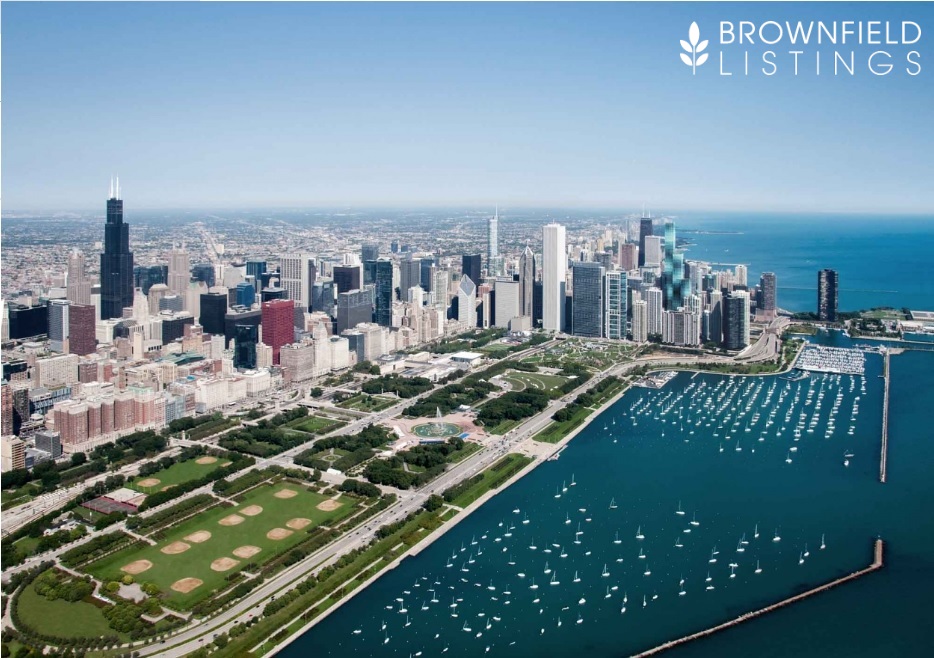
In Part 3 of this longform series by BL, we examine Chicago to better understand how its mix of amenities, infrastructure, workforce and affordability is dominating corporate investment. And why Chicago, not Columbus, is an objective frontrunner for Amazon HQ2.
Now more than a year on, the search to site Amazon’s next headquarters is shifting into prime time and the rumor mill is flying. After publishing its groundbreaking open RFP, cities across North America scrambled to present their best ideas to Amazon in the highest hopes their community might match the company’s ideal for HQ2. By October last year, 238 cities had submitted proposals including free land, billions in tax incentives and large data sets of useful city info for a chance to land a $5 billion golden goose that will eventually grow into 50,000 jobs.
In January, after receiving this deluge of data-rich proposals, Amazon trimmed its list to 20 cities for further examination. “Getting from 238 to 20 was very tough—all the proposals showed tremendous enthusiasm and creativity,” an Amazon executive noted in a statement at the time.
Since then, the company shifted to silent running. The initial explosion of energy, ideas and publicity subsided into a long year of little details—until recently when rumors, anonymous sources and “leaks” began to appear in the media and set the economic development world ablaze.
It took time because mulling all the details going into Amazon’s site selection process for HQ2 takes considerable time and attention. There’s a lot for Amazon to consider in this momentous corporate decision to double the size of Amazon’s HQ functions, but in a completely different location from its current HQ. While Amazon’s stated RFP criteria are refreshingly straightforward, there’s a lot behind each of the company’s simply-stated bullet points. Together, Amazon’s site selection recipe calls for a community winning on numerous factors essential to sustaining a healthy, competitive local economy—one that can make a compelling case of the sort a global corporate giant will need to compete in the new 21st century economy.
Amazon’s criteria call for a metro area with 1 million people and a stable, business-friendly environment. Amazon also requires an extremely strong base of local and regional labor—particularly talent in tech, business and fields core to Amazon’s future growth. Amazon’s RFP also calls for convenient access to mass transit for its future workers as well as a large international airport. Livability, quality of place and culture are also front and center, though they are harder to quantify. Amazon’s RFP calls for “urban or suburban locations with the potential to attract and retain strong technical talent” and a community that thinks “big and creatively when considering locations and real estate options.”
In the first article in this series, we began by thinking big about Amazon’s RFP and what it meant for all communities competing for growth on this new economic landscape—or for clues as to how the table of site selection, so to speak, is being reset—and then examined early rumored front-runner Atlanta’s chances to land HQ2.
In the last article in this series, we considered two more front-runners: Austin and Boston.
In this article, we’ll continue consideration of the cities in Amazon’s top 20, going in alphabetical order, to better understand how they made the list of finalists and how they’re positioning themselves to compete for HQ2 and all future opportunities. We pick up below with Chicago, which is one of the only cities on the list of HQ2 finalists with the economic size, transit system, quality of place, depth of workforce and availability of land to serve as the sole base for Amazon HQ2—even if split across multiple Chicago sites.
Chicago is also the city with the longest, hottest streak of country-leading corporate growth, which was foreshadowed somewhat by Boeing’s choice to leave Seattle for Chicago.
Is ‘Sweet Home Chicago’ Ideal for Amazon’s Second Home?
Chicago is another clear and objective front-runner. Known as the “City of Big Shoulders,” greater Chicago is a global megacity whose giant development footprint sprawls across three states. Chicago competes with super-scaled infrastructure and a substantial railway network at its spine—including, a substantial regional passenger rail system in high use. Chicago needs its robust transit system to serve its very large and diverse workforce, which moves one of the largest daily commutes in the U.S. In Chicago’s thriving downtown area, there are more workers employed, a more robust office space market and lower office vacancy rates now than at any time in the city’s history. Yet, all this is available to Amazon, or anyone else, at costs lower compared to either coast.
Chicago is home to more than 2.7 million people spread across 50 wards, 77 community areas and 100 neighborhoods. Millions more reside in the region beyond—nearly 10 million in the Chicago-Naperville-Elgin Metropolitan Statistical Area (MSA). To get around, many drive, but many also use Chicagoland’s robust public transit systems. Chicago’s “L” trains comprise the third-largest city rail system in the U.S., servicing nearly 800,000 daily riders and nearly all of Chicago’s 2.7 million residents live within a half-mile of public transit.
Chicago is an extremely walkable city as far as North American cities go. “Going car-less” is truly an option and a relatively high percentage of Chicagoans walk and bike. In fact, Chicago has the second-highest percentage of commuters riding their bikes to work of all major U.S. cities, notwithstanding its generally undeserved bad reputation for inclement weather.
‘Sweet Home Chicago‘ is internationally known as the birthplace of the blues, a music style that developed following the Great Migration, in which six million African-Americans escaped poverty, persecution and environmental disasters by moving out of the American south to the abundance of jobs and relative equality in the industrializing north. Many of Chicago’s historic neighborhoods are still intact, giving it an extremely diverse housing stock. Ukrainian Village, Greektown, Chinatown, Little Italy and Pilsen (Chicago’s historic Mexican American neighborhood named the #1 coolest neighborhood in the world this summer by Forbes) are just a few shining examples of the brilliant quality to Chicago’s character that it has somehow managed to maintain, even as urban growth drained the cultural energy out of many U.S. cities during the last century.
Chicago is a rich tapestry of civic and cultural treasures. It’s beautiful lake front is almost entirely preserved for public use and dotted by some of the finest institutions in the world, including the Field Museum, the Adler Planetarium and the Shedd Aquarium. There are nearly 7,500 restaurants in Chicago, including 7 AAA Diamond-rated restaurants, 26 Michelin-starred restaurants and some of the best restaurants in the world. Chicago is a bastion of the culinary arts and global center of certain cooking scenes, i.e. Mexican cuisine, which accounts for the fare at nearly 1 in every 11 Chicago restaurants. Chicago also hosts 40+ film festivals and 75+ music festivals each year, including Blues Fest, Pitchfork and of course Lollapalooza. There are more than 200 theaters and 250 live music venues in Chicago, as well as more than 200 professional dance companies.
If you think this stuff doesn’t matter, then you might not know the complete story of Seattle losing Boeing to Chicago in 2001.
When Boeing Left Seattle for Chicago
Despite everything true in the objective advantages of the site Boeing selected for its HQ relocation in downtown Chicago, some site selectors will tell you that Boeing would not have relocated there had Chicago’s Lyric Opera not been just across the river.
Roughly 9 months before Boeing made the destiny-altering move, it struck the company’s CEO that Boeing needed to move its HQ to fit a larger strategic shakeup. He immediately ordered a secret site selection process for relocation to begin. Boeing’s world headquarters would move out of South Seattle, though most of its Washington-based operations would remain.
”Our decision to move was a strategic business decision,” Boeing CEO, Philip Condit, said in announcing the decision on the tarmac at Midway Airport in Chicago. ”We believe that having a headquarters separate from any of our businesses will help us grow.” Boeing officials cited numerous other factors considered in choosing Chicago, including its transportation, education and quality of life. But it was ultimately his decision.
When the first public announcement of the relocation plan was made in March 2001, it caused a firestorm in the hometown where Boeing was born and raised, Seattle. Then, as with Amazon HQ2 now, government officials across the country aggressively lobbied to attract Boeing by offering substantial incentive packages and emphasizing their economic and cultural advantages over their competing cities. In the weeks and months leading up to the decision, with the region clearly in Boeing’s sites, bitter infighting took place within Chicagoland as various neighborhoods and suburban communities competed to land the new HQ for the multi-billion dollar corporate behemoth.
Then, as with Amazon now, Boeing’s site selection process remained in the dark up until the morning Chicago city officials received an early telephone call. If leaving Seattle was a shock, so too was Boeing’s selection of downtown Chicago. Whereupon Boeing’s CEO flew from Seattle to Chicago the same day to make the announcement on Midway’s tarmac.
”In the end, I said, ‘I’ve made my decision, we’re going to Chicago,’ ” Mr. Condit said.
Boeing then moved its HQ into the former headquarters of Morton International, a new office tower along the Chicago River—a beautiful building that is architecturally significant because of its use of steel trusses to support its southwest corner, which is suspended like a hanging basket above the railroad tracks that serve multiple Amtrak and Metra commuter lines running from downtown (out of Chicago’s famous Union Station). In a city of architecturally significant structures—that Chicago’s famous architectural boat tours will teach you all about—Boeing’s new Chicago headquarters stands out as an exemplary example of Chicago engineering solutions to make the city work.
The site offered unparalleled commuting optionality throughout Chicagoland with easy walkability to both major downtown rail stations, Union Station and Ogilvie Station—Chicago’s other major downtown rail station offering regional service. It was also strategically located roughly equidistant from both of Chicago’s major airports, Midway and O’Hare International. And, by car, Boeing’s new home sat on the western edge of the urban core, which is closest to interstates going in all directions. By foot, it was a short walk to the heart of downtown’s dense office cluster and the many other companies Boeing’s new HQ might be calling on, or vice versa.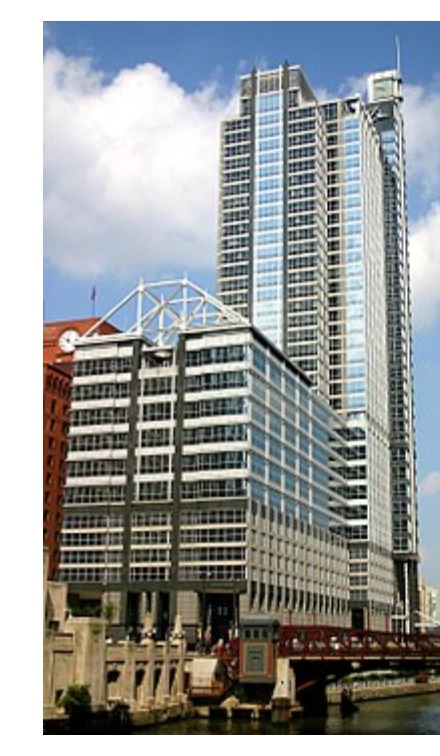
Still, the CEO’s choice of the downtown location went against a lot of conventional wisdom, which still heavily favored suburban office parks at the time.
Among all its location advantages, the new home of Boeing’s corporate brain at 100 North Riverside Plaza also happened to be just across the river from the Lyric Opera, which Mr. Condit and his wife thoroughly enjoyed. The Condit’s are passionate patrons of the performing arts and made numerous cultural investments and donations. Mr. Condit was an Eagle Scout and has been described as a brilliant engineer who rose to become a well-liked CEO by thriving in Boeing’s meritocracy for more than 35 years—and still loved after being let go. He was also known as a hands-on philanthropist, who offered his business acumen readily to worthy causes and once helped to rescue Seattle’s ACT Theatre in its relocation from Queen Anne to downtown Seattle. Years later, immediately before he was let go as Boeing CEO barely two years after moving its HQ to Chicago, the Condit’s made a surprise donation of $500,000 to Seattle’s ACT Theatre—even though they were living in Chicago.
So, it’s a strong possibility that Chicago’s world class theatre scene was an effective selling point in the Condit household. And its abundance of performing arts, culture and other downtown amenities was a major selling point for the city of Chicago in its pitch for Boeing, and one it can make strongly on the back of a portfolio of world class institutions and centers. Chicago is thought by many to be the theatre capital of the nation. It is the birthplace of storefront theatre and improv comedy—and today the famous Second City continues to produce some of the country’s most beloved talents. Chicago also boasts more world premieres than any other city in the country by virtue of its 250+ theatre companies taking the stage in the city’s more than 200+ theatres. Theatre-goers in Chicago can choose from thousands of widely diverse performances each year in multiple languages and diverse venues ranging from the grand historic downtown theatres to the many more tucked away in neighborhood storefronts.
Boeing’s new Chicago HQ lay a short walk over the river to Chicago’s magnificent Lyric Opera and mere blocks from its theatre district. Mr. and Mrs. Condit could have chosen worse.
Whether Boeing’s HQ relocation really came down to the Lyric Opera or not, Boeing was not going to be pitching its tent in downtown Chicago all by itself. Boeing joined a cadre of other Fortune 500 companies based in Chicagoland—with more than a dozen already located within the city limits and nearly two dozen more in its vast suburbs.
When Boeing’s secret HQ site selection hunt proceeded to its more competitive stages and its scouts and executives got boots on the ground, Chicago’s rolled out the red carpet in an attempt to convince Boeing to pick Chicago over other top choices, Dallas and Denver. Chicagoland’s corporate community rallied with city and state officials in a full court press to make the business case.
Their message was simple and genuine: they loved Chicago because it really was “the City that Works.” Chicago was working for them because it was balanced, diverse, centrally located and had a deep bench of talent drawn from across the Midwest and North America. The overall quality of place and quality of life in Chicago was world class, Chicago’s corporate community told Boeing in 2000, capable of attracting global talent and running a global operation, as they were.
Chicago’s formula for success lay in its history of dynamism and can-do attitude. Unlike most other larger cities in the Midwest, Chicago’s economy is multidimensional, and it largely avoided the trap of monoculture economic development that plagued so many of its Great Lake counterparts, e.g. Detroit.
Chicago: Corporate Capital of the North American Interior
The objective case for Chicago is compelling. In the years that followed, many other corporate executives would bite on the same pitch for Chicago that Boeing did in 2001. In fact, Chicago has led all metropolitan areas as the #1 city for corporate growth for 5 years in a row.
According to Site Selection magazine’s Conway Project Database, last year Chicago landed more than twice as many corporate facility investments compared to second place (402 vs. 196 in Houston). But this project tally was slightly down from 2016 when Chicago racked up 424 major corporate investments, which was higher than its marks of 376 in 2015 and 385 in 2014. All good enough for Chicago to lead the nation in each respective year.
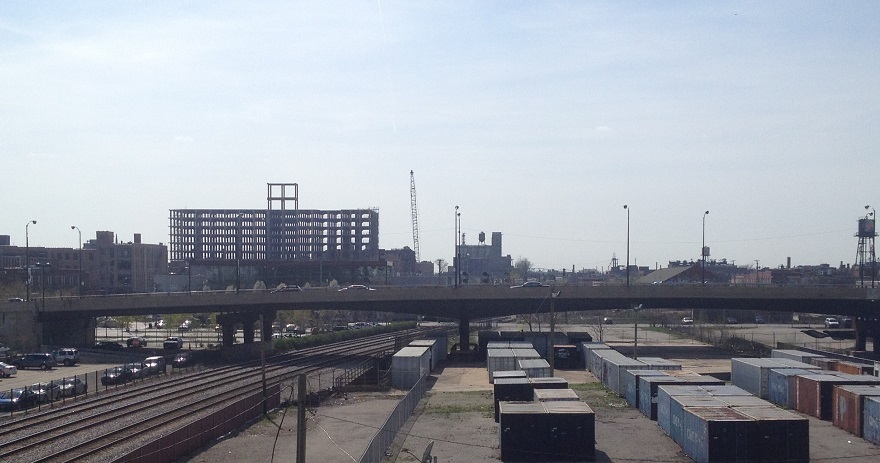 Structural skeleton of Google’s office in Chicago’s Fulton Market neighborhood, triggering an office boom along with city transit investments.
Structural skeleton of Google’s office in Chicago’s Fulton Market neighborhood, triggering an office boom along with city transit investments.
This year it was suburban stalwart, McDonald’s, that relocated its HQ and Hamburger University to downtown Chicago’s hot West Loop/Fulton Market neighborhood. But as big of a move as that would be for any community on its own, McDonald’s is merely one in a historic series of corporate investment into Chicago that has created tens of thousands of jobs and billions of investment dollars in recent years.
Google was the first major office expansion into Chicago’s Fulton Market neighborhood, when it invested in the massive redevelopment of an enormous cold storage building in 2013. Soon followed major corporate relocations or expansions elsewhere in Chicago, including: Caterpillar, Mars Wrigley, Wilson Sporting Goods, Motorola Solutions, Kraft Heinz, ConAgra, Mead Johnson Nutrition and many others. It’s become common for as many as four Fulton Market office projects to come before the Plan Commission in one meeting, with as much office space in this hot Chicago neighborhood under development to surpass that in Willis Tower.
Many industry segments are thriving, but technology is driving substantial growth on Chicago’s “Silicon Prairie.” It’s building a reputation for having its own winning recipe for startup incubation and business investment. And the results to back it up. Chicago’s biggest business incubator, 1871, is ranked first in the world on the 2018 UBI Global list of Top University-Affiliated Business Incubators. Inspired by the year of the Chicago fire, 1871 has had a tremendous impact on the local tech scene and helped to fuel Chicago’s corporate boom since opening its doors in the old Merchandise Mart in 2012. Home to eight university partners with a number of accelerator programs and early-stage venture firms, 1871 hosts over 1,000 events a year, graduates hundreds in coding, design, and cybersecurity and 1871 companies have raised over $280 million in funding and created over 8,000 new jobs–enough to launch one of 1871’s founder, J.B. Pritzker, in a successful bid for Illinois Governor.
So, Chicago has built a kind of development dynasty with respect to corporate investment in recent years. And it’s positioning itself for success in the future. This is a major reason why Amazon was back to Chicago for additional visits and it’s such a strong candidate. And also why Apple has been looking under the hood in Chicago for its own corporate HQ expansion.
Chicago was Built on Big Visions
Chicago is known as the “Second City” after a tough competition with New York to be the site selected for the Columbian Exposition in 1891, which Chicago actually won. Today, Chicago is the second most visited city in the U.S. Tourists are going to Chicago in record numbers, breaking the 50 million annual tourist mark in 2014—behind most-visited New York City by only a few million. Chicago tourism is up, even though overall U.S. travel is down, which is emblematic of Chicago’s growing economic and cultural force of gravity.
Chicago’s robust travel demand has hotel developers playing catch-up with a boom of downtown hotel construction. One of many mini-booms manifesting in Chicago all at once in recent years, raising more cranes than most any other U.S. city save Seattle. This year, in fact, Seattle was first by number of tower cranes for the third year in a row with 65 cranes in the air, followed by Chicago’s 40. Unlike land-constrained Seattle, Chicago can infill comfortably, with plenty of land to grow into the 21st century.
In Zillow’s affordability study measuring the impact on home prices from HQ2, Chicago scored among the top of the range among contending cities. It stems from Chicago’s large size and relative abundance of developable land compared to most of its HQ2 competition.
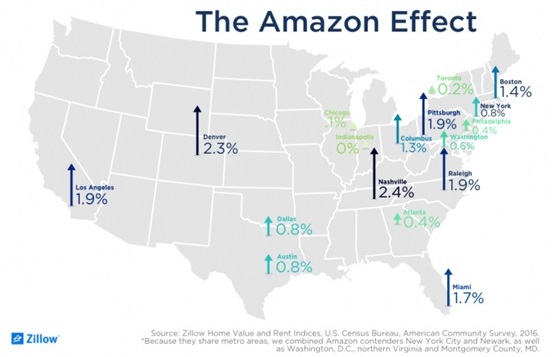
Chicago is getting the best of the shift toward re-urbanization. It recently passed a new measure to widely expand transit-oriented development (TOD) zoning around public transit points (potentially to soon include certain bus corridors as well), which will open hundreds of acres to denser development patterns. Based on the early results of a few dozen projects that managed to create more than 5,000 housing units, Chicago’s Metropolitan Planning Council projected in 2016 that up to 70,000 new housing units would be built over the next 20 years just as a result of its groundbreaking TOD ordinance. Chicago suffers from gentrification like most cities, and a large number of high-end units are coming online, but city planners are putting in the tools to combat runaway home prices and rebuild with affordability in mind—even a developer fee on projects built in the ultra-hot urban core that is pooled and shared by Chicago’s communities flung further afield and not benefitting from where the majority of reinvestment is taking place.
Chicago’s supersized-yet-affordable dynamism is working to its advantage. Corporate America is making steady and large investments because Chicago has the scale they need, at a price they like and with plenty of room to grow. It’s big enough to recently become home to the largest Starbucks in the world.
Chicago has a long history of going big, being bold and, at times, even brash. It’s known as the “Windy City,” not because of the wind blowing off Lake Michigan, but rather the hot air said to come from Chicago’s public and private sector leaders throughout history. Chicago’s leadership has a tradition of striving for big visions, which has been passed down at least since the city rebuilt itself from the ashes of a catastrophic fire that laid waste to 3.3 square miles of Chicago and nearly burned every structure to the ground in 1871—only 20 years before Chicago won the competition to host the Columbian Exposition.
It took a series of incredible civic mobilization and civil engineering achievements to build the canals, railroads and infrastructure that made Chicago the North American interior’s greatest city. To alleviate chronic and deadly health complications as a result of environmental pollution in the way, Chicago began planning to dig under Lake Michigan before the Civil War. By 1866, the first tunnel dug 2 miles directly east, headlong under Lake Michigan, was completed by men digging through clay pulled away in carts by mules. It was dangerous work, but Chicago needed clean water and it needed to pull it away from the polluted city.
During this period of the city’s young history, Chicago’s elevation was not much higher than the shoreline. After development, with no naturally occurring drainage, the abundance of standing water in the city’s built-environment had become putrid. Typhoid fever and dysentery swept through the city six years in a row, which culminated in the 1854 outbreak of cholera that killed roughly six percent of Chicago’s population.
Everyone who’s taken a drink of water in Chicago in the last 150 years can thank the vision to construct the now massive under-the-lakebed system tunnels and pipes that pull clean water from the water harvesting “cribs” safely offshore. 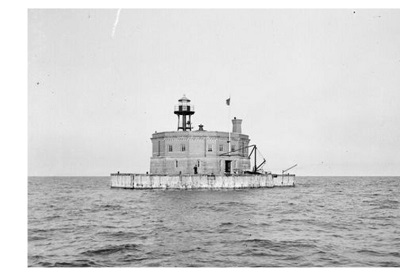
Also, thanks to the big-shouldered civil war generation, anyone walking through downtown Chicago is doing so on the second floor. Throughout the 1850’s and 1860’s, endeavoring to find more permanent solutions to manage its water challenges, engineers in Chicago underwent a piecemeal process to raise the first level of Chicago’s entire city center, known as “the Loop” today. In 1856, the city’s Common Council adopted engineer Ellis Chesbrough’s plan for a citywide sewerage system, whereupon workers laid new drains, rebuilt roads and raised sidewalks to the new grade.
This huge undertaking to literally raise the city up was funded in an early kind of public-private partnership that deployed capital from private property owners and public monies.
Buildings were often physically raised as well on hydraulic jacks or jackscrews. In January 1858, the first brick building in Chicago—a four-story, 750-ton brick structure located on the northeast corner of Randolph and Dearborn Streets—was raised on two hundred jackscrews to the city’s new grade, which was 6 feet 2 inches higher than the original. In the decades that followed, Chicago’s built-environment leadership continued to thrive, perhaps by necessity in the wake of its epic fire. By the 1880’s and 1890’s, the architectural pioneers of the Chicago School began exploring steel-frame construction and plate glass to start building the first modern skyscrapers and, in 1883, the Montauk Building, designed by John Wellborn Root Sr. and Daniel Burnham, finished its unique construction using structural steel.
In 1900, Chicago reversed the flow of the Chicago River through a series of man-made hydrologic connections between the Great Lakes and Mississippi watersheds using a series of canals and locks. Chicago’s more recent Deep Tunnel Project, a long term effort to build a series of massive reservoirs able to divert storm water and store sewage in order to reduce flooding and minimize the harmful effects of flushing raw sewage into the watershed, is just the latest in a series of mega civil engineering projects in Chicago’s battle to master its bluefields—a score on which Chicago fares much better than any of its coastal competition, at least from a risk management perspective.
Chicago’s might today stands on a strong foundation of civic and civil achievement that’s built many jewels in its crown thanks to more than a century of visionary planning and execution. Among these is Chicago’s park system, also designed by Daniel Burnham, which you might consider as a physical crown system with lots of jewels purposely, thoughtfully placed within.
Chicago’s Amenity War Advantage: Substantial Green Assets and Framework for Growth
Believe it or not, Chicago is one of the greenest cities in the entire world. Chicago’s colors may be blue, white and red, but green is in Chicago’s DNA—and not just because it famously dies a portion of its river green for its enormous St. Patrick’s Day celebration, one of the largest such celebrations anywhere in the world outside Ireland. This year, for the second year in a row Chicago was named the greenest city in the U.S. by the U.S. Green Building Adoption Index, again claiming the top spot with nearly 70% of its space green certified. Chicago has long been a leader of movements to green our cities and is going even greener today to extend its competitive advantage.
The city’s official motto since the 1830’s has been “Urbs in Horto,” which is Latin for “City in a Garden.” The City of Chicago devotes ~8.5% of its total land acreage to parkland, one of the highest shares in the country, with much more land in parks and preserves nearby in greater Chicagoland’s historically rich farmland and wet prairie. Chicago also possesses more green roofs than any other U.S. city, with over 5 million square feet. And Chicago’s Garfield Park features one of the grandest conservatories in America, with one of its largest greenhouses.
In total, Chicago has more than 600 parks. The Chicago Park District manages 220 facilities on its more than 7,600 acres throughout the city, which includes nine lakefront harbors spread over 24 miles of open lakefront. In fact, the Chicago Park District is the nation’s largest municipal harbor system, along with 31 beaches, 17 historic lagoons, 86 pools, 90 playgrounds, 90 gardens, 9 ice skating rinks, 10 museums, a zoological park, and two plant conservatories. As an amenity, the “North Coast” is truly an American treasure.
Like much of the city itself, many structures in Chicago’s park system possess exceptional architectural value. Famous architects, artists and landscape architects, including Frederick Law Olmsted, Jens Jensen, Dwight Perkins, Frank Gehry, and Daniel Burnham, contributed their brilliance to the construction of Chicago’s park system. Portage Park and Jefferson Park are each listed on the National Register of Historic Places. Most of Chicago’s park fieldhouses are varieties of either Georgian or Classical Revival architecture, many designed by Clarence Hatzfeld.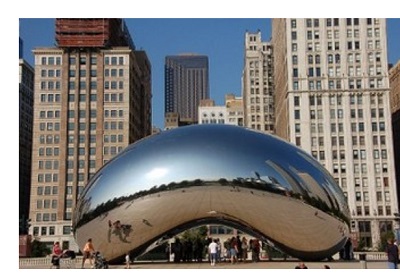
More recent achievements include Millennium Park, with free admission and award-winning accessibility where billions of selfies are taken in front of Chicago’s famous “Cloud Gate” sculpture (the Bean, shown right). Constructed atop a commuter rail station (Millennium Station) and parking lot, Millennium Park is the world’s biggest rooftop garden. It spans the northwestern 24.5-acre corner section of historic Grant Park on the Lakeshore.
The rooftop park is connected by the BP Pedestrian Bridge and the Nichols Bridgeway to other parts of Grant Park. And it was a significant redevelopment achievement, turning land previously occupied mostly by ugly rail yards and parking lots into perhaps the city’s crown jewel—by literally crowning the most beloved and useful space in a massive elevated redevelopment—years before the Highline redeveloped an abandoned railway in New York.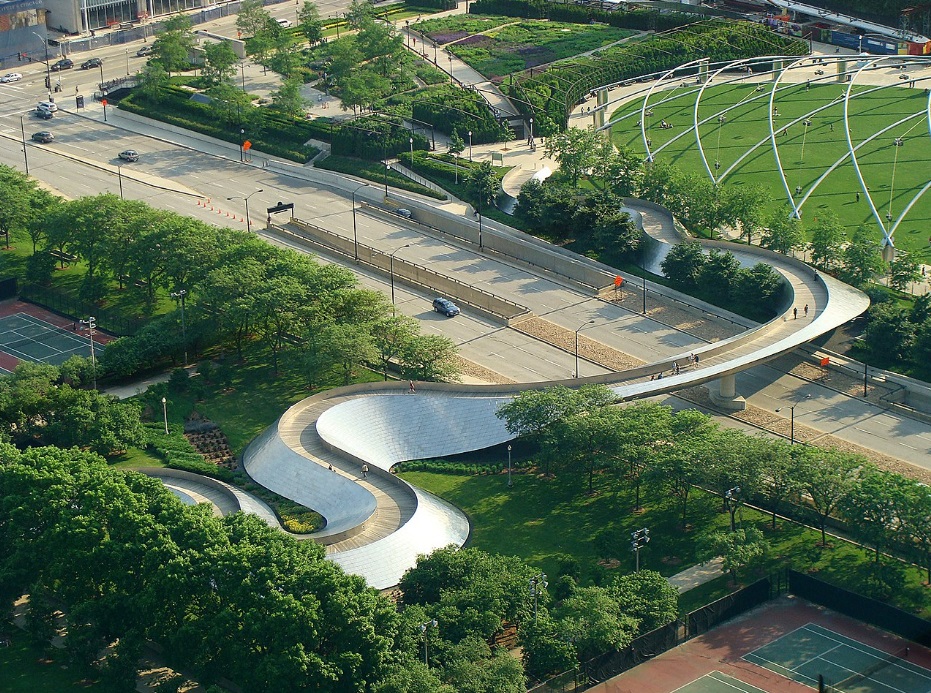 How beloved and useful is Millennium Park to Chicago? It is now the top tourist destination in Chicago as well as the entire Midwest in 2017, surpassing long time #1 Navy Pier (not too far from Millennium Park). And not too much further north is Lincoln Park, Chicago’s largest park, which is also one of the county’s most-visited parks because it attracts over 20 million people each year. A major attraction there is the 35-acre Lincoln Park Zoo, which was founded in 1868 and is one of the oldest zoos in North America. It is also one of America’s last free zoos.
How beloved and useful is Millennium Park to Chicago? It is now the top tourist destination in Chicago as well as the entire Midwest in 2017, surpassing long time #1 Navy Pier (not too far from Millennium Park). And not too much further north is Lincoln Park, Chicago’s largest park, which is also one of the county’s most-visited parks because it attracts over 20 million people each year. A major attraction there is the 35-acre Lincoln Park Zoo, which was founded in 1868 and is one of the oldest zoos in North America. It is also one of America’s last free zoos. 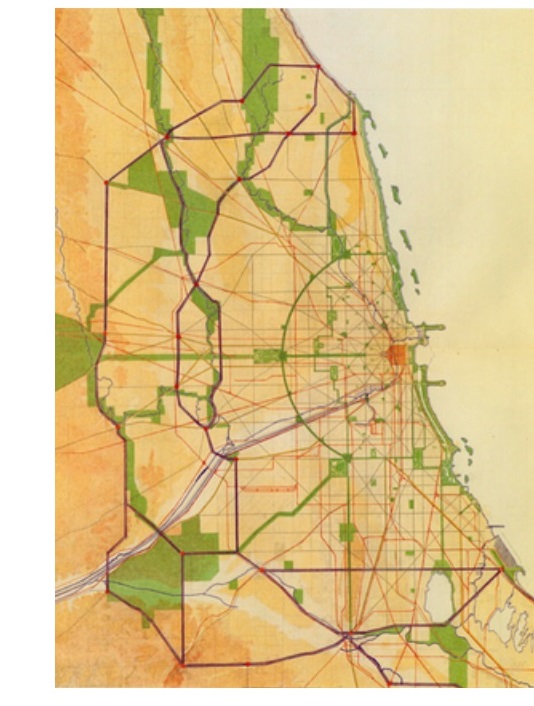
Daniel Burnham, already mentioned more than once above, deserves a lot of credit for the beauty of Chicago’s park system and its balance between aesthetics and function. The Burnham Plan became the popular name for the 1909 Plan of Chicago, co-authored by Burnham and Edward Bennett. In the plan were recommendations for a series of related projects that would construct new and widened streets, parks, new railroad and harbor facilities, and civic buildings. Though only portions of the plan’s total vision have been realized, so far, it’s proven to be a foundational document that profoundly reshaped Chicago, especially in its central areas and lakeshore—not to mention the very foundations of city planning.
After the fair, Burnham—the architect who had managed the construction of the 1893 World’s Columbian Exposition in Chicago—debriefed that success by preparing and presenting grander ideas for improving Chicago’s lakefront. Foremost among the plan’s goals was reclaiming the lakefront for the public. “The Lakefront by right belongs to the people,” Burnham wrote. “Not a foot of its shores should be appropriated to the exclusion of the people.”
Burnham saw the underutilized potential of Chicago’s lakeshore and recommended expanding the parks along the Lake Michigan shoreline with landfill. Yes, landfill. Chicago was experimenting with large scale landfill development more than a century ago.
Today Chicago is leading on multiple fronts, including green roofs, green buildings, TOD and Pedestrian-Oriented Development (POD)—that includes extensive bicycle infrastructure investment in recent years. Chicago maintains over 300 miles of official bike lanes, 13,000+ bike racks as well as a 40-acre bike path specifically for BMX and trail-riding. Since 2011, Chicago has added more than 115 miles of protected bike lanes, 255 miles of on-street bike lanes and 5 miles of off-street trails. Most recently, Chicago began redesigning its urban core with dedicated bus lanes and more protected bikeways with their own street signals. 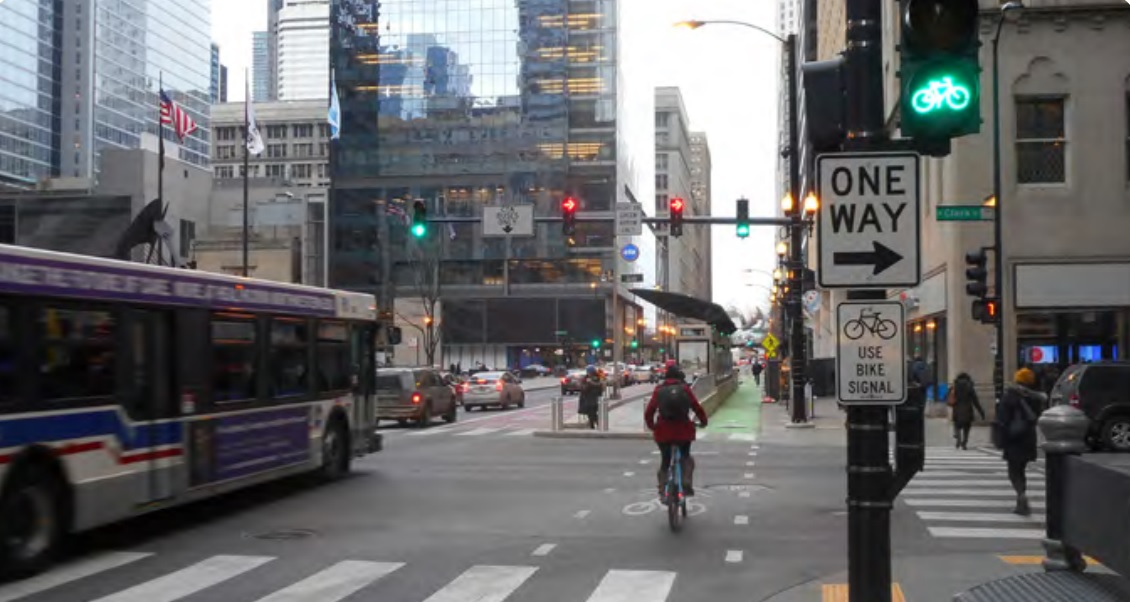 New dedicated bus lane and protected bike lane with its own “bike signal” in downtown Chicago.
New dedicated bus lane and protected bike lane with its own “bike signal” in downtown Chicago.
Among other awards in recent years, Chicago was named America’s Best Bike City by Bicycling Magazine in 2016. Chicago’s decision to embrace alternate modes of transit, with pedestrians as a key orientation, has given more options to residents and tourists alike. By investing in greater transit optionality and pedestrian infrastructure, Chicago has enhanced its already excellent walkability and extended its green lead, while simultaneously enhancing its quality of place, making it safer to bike in the city and improved access for everyone in Chicago, regardless of age or transit insensitivity.
Seizing of Burnham’s highest ambitions for Chicago’s built-environment, the city’s latest achievement in the new age of urban amenity is known as the 606 Trail or Bloomingdale Trail. The elevated, abandoned rail line was reborn in a $95 million pedestrian oriented development that is roughly 3 times longer than the Highline. The 2.7-mile elevated park runs east-west through four vibrant, Chicago neighborhoods with an expansion already planned that will include 32 acres of linear park space at the trail’s present terminus along the Chicago River (more on that below).
Like Atlanta’s beltline and the Highline before, Chicago’s 606 Trail has triggered a tsunami of investment—with the majority of development producing high-end units.
Chicago’s Most Precious Crown Jewel is its People and their Work Ethic.
Michael Jordan said he liked Chicago because it was a blue-collar town. Its people were like him, they worked hard and took pride in doing it. Throughout its history, industry after industry have come to Chicago, scaled and thrived. And so, for generations, millions of hard-working people have migrated to Chicago to take up work. Mark Twain might not have believed that Chicago and not St. Louis was today’s North American megacity, but such was the dominance of rail and related industries in Chicago, including meatpacking.
Later, Chicago became a mighty merchant city. For a generation, Chicago-based companies like Sears and Montgomery Ward dominated the retail business through mail order and other innovations. The era of big department stores and mail order catalogues came and went, but the busts of Chicago’s prominent merchants line the Chicago River in front of the Merchandise Mart, which was the largest building in the world with 4,000,000 square feet under roof, when it opened in 1930.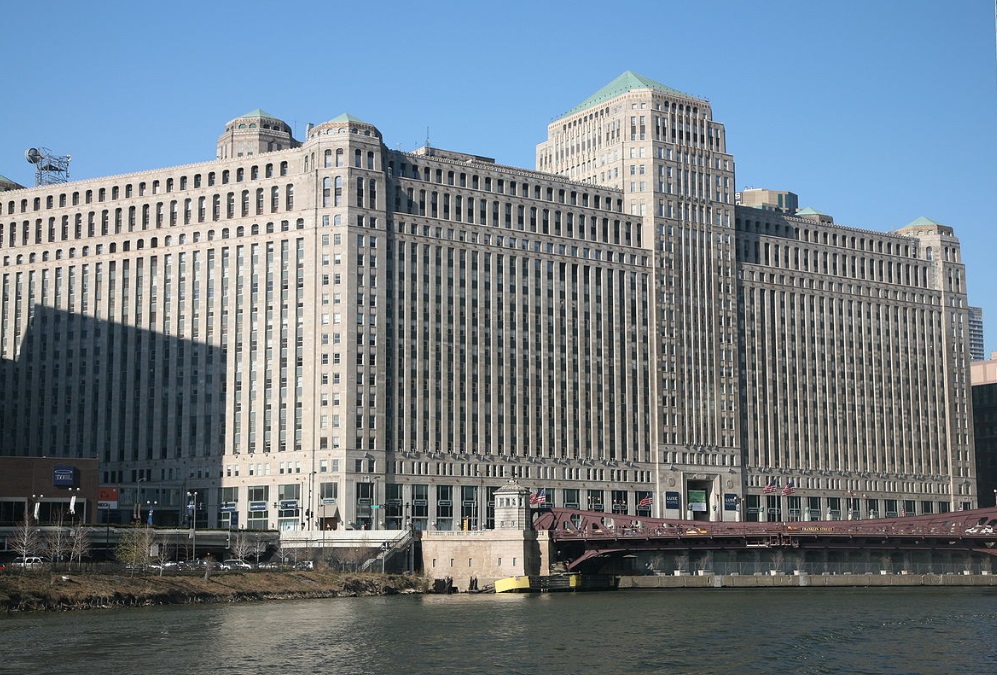 Should Amazon fly its merchandising flag in Chicago and take up its legacy of mercantile leadership there, perhaps Jeff Bezos will get his own bust in front of the Merchandise Mart someday.
Should Amazon fly its merchandising flag in Chicago and take up its legacy of mercantile leadership there, perhaps Jeff Bezos will get his own bust in front of the Merchandise Mart someday.
Today, Chicago’s business ecosystem is stronger than ever thanks in part to record corporate investment—even as the state as a whole has floundered. Office vacancy in the Loop hasn’t been lower since WWII. And yet, in spite of ceaseless growth adding 10,000+ jobs in recent years, Chicago’s labor market is still not quite as tight as it’s competition in Austin and Boston. 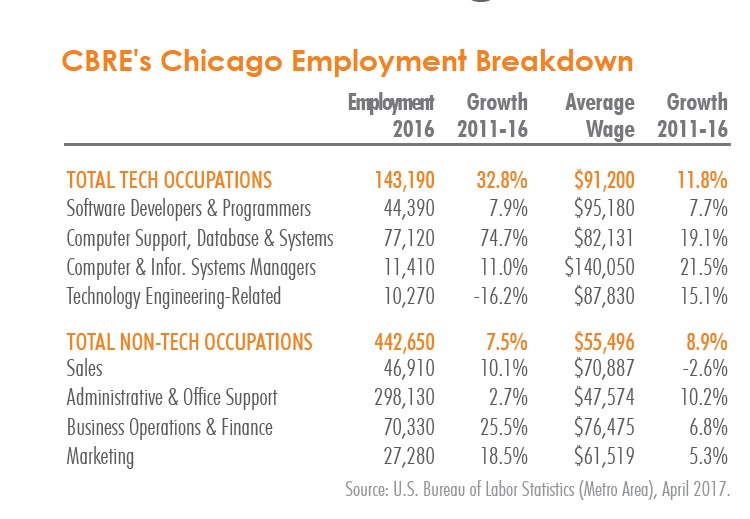
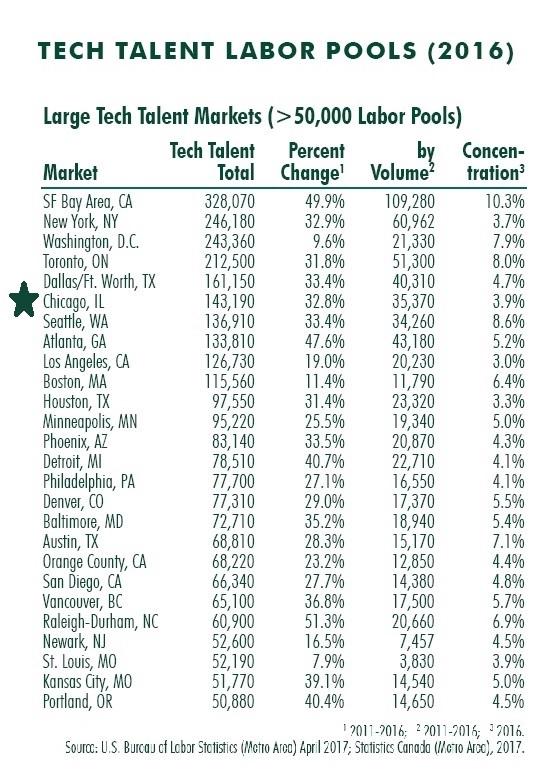
Now the nation’s third largest city, Chicago’s economic ecosystem is capable of feeding professional sports teams in each major league, including two Major League Baseball (MLB) teams, as well as numerous minor league franchises. At the collegiate level, Chicagoland functions as the unofficial capital and geographic hub of the Big Ten conference and it draws more Big Ten graduates than any other city in the Midwest by far. Many of the region’s top students attend the elite universities in Chicago’s geographic orbit, including the University of Illinois in nearby Urbana, a global technology and business leader, the University of Wisconsin in nearby Madison and Northwestern University in Evanston on Chicago’s north side. Indeed, top students from around the world travel to the Midwest to attend its many excellent universities.
Almost as a rite of passage in early life after graduation, many Big Ten students move to one of the many young, hip neighborhoods in Chicago to take jobs in the biggest urban center of the North American interior. For decades, young professional Big Ten graduates have visited friends in Wrigleyville or other historic (and cheap) neighborhoods and enjoyed good times in Chicago’s rich tapestry of experiences.
And while dominating the Big Ten and other regional institutions, the Ivy League also sends a significant quantum of alumni to Chicago as well.
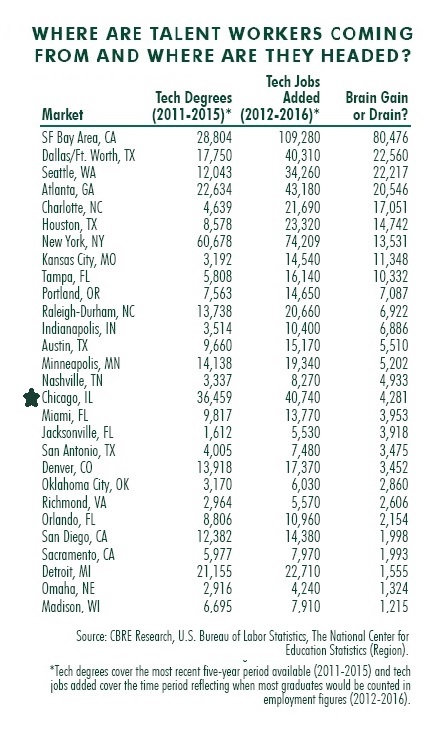
So, the secret to Chicago’s recent success in corporate investment is its people. Chicago’s deep, dynamic workforce and Chicagoland’s ability to attract new workers and add housing for them without driving prices high is in a class by itself. Other cities have larger tech talent pools, led by the Bay Area, New York and D.C., but Chicago is largest by size only behind those three biggest tech talent cities as well as Toronto and Dallas. At 6th largest on CBRE’s 2017 Tech Talent Report, Chicago’s 143,190 tech workers had grown above average at 32.8% in the preceding 5 years (see right).
It’s concentration of tech workers, however, was among the lowest of large markets, at 3.9%. Overall, Chicago’s large labor force is extremely well balanced. No single industry accounts for more than about 15% of Chicago’s economy. It’s leading occupational categories include, administrative and office support (298,130), business operations and finance (70,330), sales (46,910) and marketing (27,280)—all vital functions for modern corporations and attractive resources for today’s people-starved companies.
Chicago scored a net brain gain in last year’s CBRE Tech Talent Report, with 36,459 tech degrees generated but 40,740 tech jobs added in the ensuing five year period—for a net brain gain of 4,281 tech workers. And in the same report, CBRE ranked Chicago #15 overall for tech talent.
In CBRE’s most recent 2018 report on tech talent, Chicago fell to #18 and slipped to a net brain drain. But with real estate prices relatively affordable and land relatively abundant, corporations continue to make investments into Chicago’s growing urban corporate community.
In the era of labor scarcity, Chicagoland’s great people have proven themselves worthy of more corporate investment than any other city for five years in a row, as discussed above. And Chicago’s structural advantages in site selection processes continue to strengthen as its business ecosystem expands well beyond critical mass and corporations continue to grow into new symbiotic value chains.
Recently, Google has been rapidly growing its presence in Chicago with plans for thousands more employees, including an engineering lab that will be the only U.S. hardware lab outside its main offices in Silicon Valley. Google has also recently been working with Chicago-based Motorola, which has also recently become an investor in downtown Chicago in part to benefit from the cross-pollination that becomes possible in a corporate ecosystem as diverse and robust as the one emergent in Chicago. On Chicago’s Goose Island, the new Digital Manufacturing and Design Innovation Institute will be located just northwest of Chicago’s downtown office cluster. The $320 million public-private partnership, known as the UI Labs, was partially funded by a $70 million award from the Department of Defense and joins 1871 and many other Chicago efforts to encourage technology development and support business growth.
Facebook is also hiring big in Chicago. “Chicago has been our Midwest home since 2007, and we’re excited to grow our presence here with increased hiring and a new office at 151 North Franklin,” Facebook’s U.S. Head of Industry Matty de Castro told the Chicago Tribune. “Our continued investment in this community underscores its strong talent pipeline and thriving technology ecosystem, which make it a great location to expand our global marketing solutions and recruiting teams.” Walgreens will be joining them soon too, per its plans to make a major investment in Chicago’s long awaited redevelopment of the Old Main Post Office.
Chicago’s Air Advantage
While Atlanta benefits from having the largest airport in the world, Chicago has two major airports with passenger service and a third large airport. Its biggest and best known is O’Hare International Airport (ORD), which is located on the city’s far northwest edge, 14 miles from the Loop. Innovative for its time, O’Hare’s design pioneered elements such as concourses, direct highway access to the terminal, jet bridges, and underground refueling systems. The first major airport planned in the post-war period, ORD became famous as the first “World’s Busiest Airport” of the jet age and remained so from 1963 to up until 1998.
Today, ORD is the world’s sixth-busiest airport and served nearly 80 million passengers in 2017. O’Hare is unusual in that it serves as a major hub for more than one of the three U.S. mainline carriers; it is United’s largest hub in both passengers and flights, while it is American’s third-largest hub—but air service to Chicagoland is served by two additional major airports. O’Hare’s air-cargo business is flying high too.
Chicago Midway International Airport (MDW) serves an additional 22+ million air passengers in and out of Chicago each year. Only 8 miles from the Loop, MDW serves as a hub for Southwest Airlines as its largest focus city.
Meanwhile, to the southeast across the Indiana border, Gary/Chicago International Airport (GYY) is not a big commercial passenger airport, but a large joint civil-military public airport in Gary where a National Guard installation has been built. Located 25 miles from the Loop, it benefits from excellent access to nearby interstates I-90, I-80, I-94, I-65 as well as the Chicago Skyway. GYY bills itself as Chicago’s “third airport” and numerous businesses, including Boeing, Menards and White Lodging Services, base their corporate aircraft here. Its administration is presently courting airlines aggressively thanks to the recent completion of its runway expansion from 7,003 to 8,859 feet after 50 years of negotiation to relocate nearby railways.
This week, the City of Chicago shortlisted 5 architects for an $8.7 billion expansion of O’Hare, which is the first in nearly 25 years. The massive redevelopment will increase the total terminal space from the current 5.5 million to almost 9 million square feet. Terminal 2 will be torn down and replaced with the new “O’Hare Global Terminal,” able to accommodate new larger planes flying internationally. Terminals 1 and 3 will undergo renovation, Terminal 5 will be expanded for passengers flying out of O’Hare when construction is complete eight years from now, making it easier to navigate thanks to dozens of new gates and a streamlined security design.
Perhaps overdue, the mega-project is an important element to Chicago’s competitive advantage. “This is an opportunity to write the next chapter in Chicago’s legacy of architectural ingenuity,” said Mayor Emanuel, according to the Chicago Sun Times, “while sharing the iconic architecture and design Chicago is famous for with visitors from across the country and around the world.” Wasting no time, Chicago’s City Council approved $4 billion in loans to get the project started.
But perhaps the most exciting airport and transit related news this year in Chicago came from Elon Musk securing the contract to build a new tunnel from downtown to O’Hare. Mayor Rahm Emanuel approved the Boring Company’s ambitious plan to dig and construct next generation subterranean high-speed rail service. While there are doubts about Mr. Musk’s highest ambitions for his boring company—to create a massive interconnected continental rail system—Chicago’s stable clay soil is likely the perfect subsurface environment in which to try, much as it was for skyscraper innovation in Chicago during a past age.
Reminiscent of Chicago digging horizontally under the lake in the 19th century, the Boring Company boldly plans to transport passengers between O’Hare and Block 37, located deep in the heart of Chicago’s Loop, in just a 12-minute one-way trip—a dramatic improvement from the typical 40-minute trip via the city’s Blue Line light rail service and the longer trip by car even without traffic.
The Chicago Tribune reported the total cost for the project is estimated to be less than $1 billion. And the project will be funded entirely by the company with no taxpayer subsidy. Under the deal between Elon Musk and Mayor Emanuel, the Boring Company will front the construction costs and then pocket all the revenue from the system’s transit fees and any money generated by advertisements, including in-car sales. According to the Mayor’s office:
Each vehicle will carry up to 16 passengers, plus their luggage, and will depart from O’Hare and from Block 37 as frequently as every 30 seconds. The Boring Company plans to charge fares below the [request for proposals] requirement that this premium service should cost less than current taxi and ride-share services. The company plans to utilize the unfinished underground transit station at Block 37 and create a new station at O’Hare.
Taken together, previously undreamable speeds from downtown Chicago to O’Hare’s multi-billion dollar upgrade paints a very blue sky indeed.
“If you look at the history of Chicago … every time we’ve been an innovator in transportation, we have seized the future,” Emanuel said in an interview with the Tribune. “I think figuring out — when time is money — how to shrink the distance between the economic and job engines of O’Hare and downtown positions Chicago as the global leader and global city in the United States.”
Chicago’s Large Urban Sites Offer Terrific Locations with Excellent Transit Service. 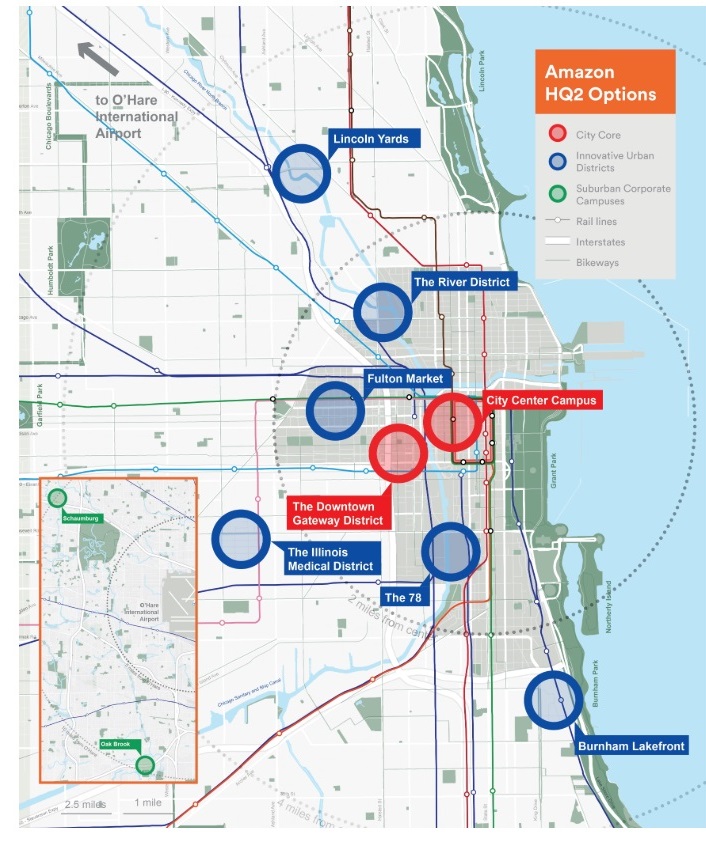
Chicago comes to the Amazon site selection party dancing with numerous large sites with substantial potential. In its official bid for HQ2, Chicago included no less than 10 sites in its proposal packet. Many are quite large and extremely well located, even adjacent to some of the largest commuter rail stations in the world, such as the Downtown Gateway District sites straddling both major downtown stations: Union and Ogilvie.
The Old Post Office and the 78 are located across the street and across the river, respectively, from Chicago’s Union Station, which is about to undergo its own $1 billion redevelopment after being placed on President Trump’s “Emergency and National Security Projects” list of 50 top infrastructure priorities. This spring, Union Station will begin to work on a new seven-story glass-and-steel addition on top of its main building. The upper floors of Union Station’s existing structure will be redeveloped into a 330-room hotel above the train platforms and improvements in the station will include a food hall of 15,000 to 20,000 square feet. The Great Hall will also be improved and new ground-level retail will be installed along the exterior of the building and interior pedestrian corridors.
Other sites in Chicago’s proposal seem more like pitches for secondary areas that are primed to absorb the ecosystem or related businesses that will move in, scale up or startup in Amazon HQ2’s orbit in support. Fulton Market, mentioned above, is among the hottest neighborhoods in the U.S. both for its cultural panache, thanks to “Restaurant Row” that runs east-west in between Randolph and Fulton Market streets featuring many of the city’s best chefs, and the intensity of the office development in the wake of Google’s expansion into the former cold storage building there 5 years ago.
It’s a fantastic neighborhood that’s also now home to the new McDonald’s HQ, but an HQ2 tucked into the West Loop would require many more deals to develop the much greater number of properties required to fit Amazon’s new co-equal branch. 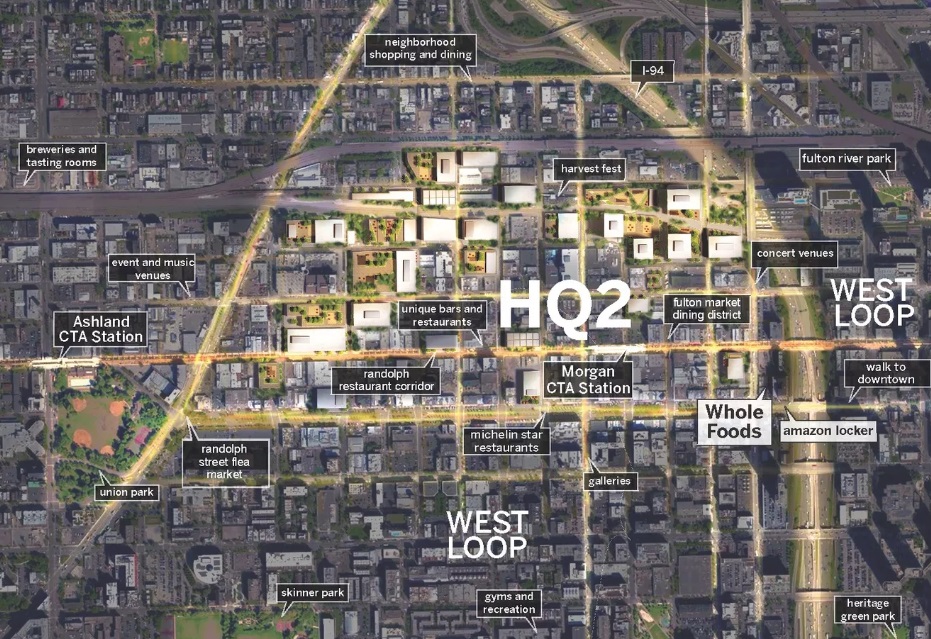 Chicago’s conceptual plan for its West Loop neighborhood.
Chicago’s conceptual plan for its West Loop neighborhood.
And since the ease and optionality presented by the opportunity to develop a larger, single master-planned property is most likely for Amazon, we’ll focus our attention on Chicago’s best sites to fit HQ2.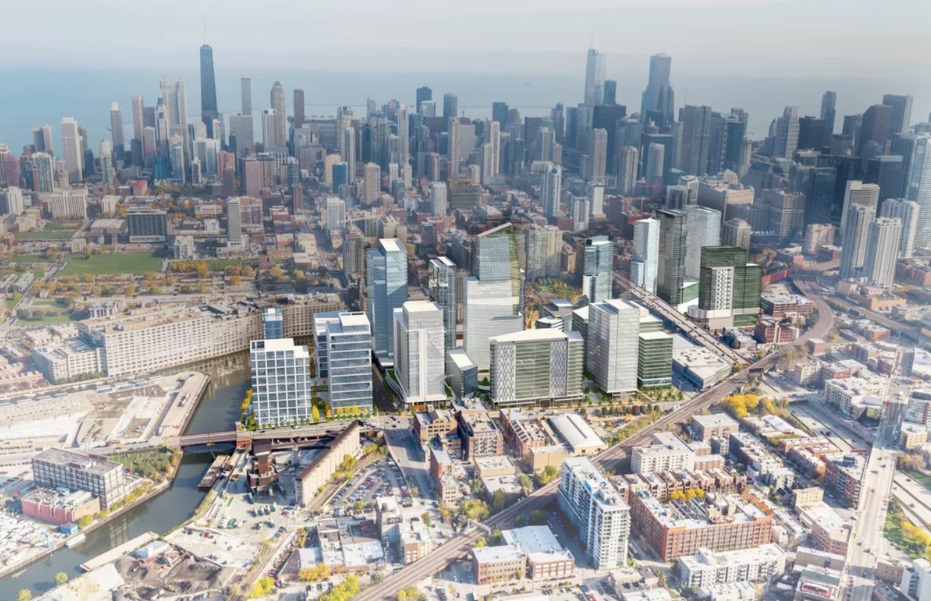 Chicago’s plan for its river district.
Chicago’s plan for its river district.
The River District
Northwest of the Loop, along the North Branch of the Chicago River, the River District is a 37-acre waterfront property owned by Tribune Media. The site is located within walking distance of numerous CTA stops and lays on two major bus corridors that could easily accommodate direct water-borne taxis to Union Station on the riverfront, for example, which is already served by water taxis—and may soon be served by air taxis flying above the river. Located in the River West neighborhood, across from the trendy River North neighborhood, the largely open greyfield site was primarily used for distribution purposes and parked vehicles on its expansive paved lots. It’s a development specimen of rare size so close to downtown and would provide Amazon with a practically blank slate. Conceptual renderings for the site came from architects Solomon Cordwell Buenz and Goettsch Partners and call for 10+ million total square feet of mixed-use space.
The Old Post Office
Long overdue, plans to finally redevelop Chicago’s enormous Old Post Office are underway. Built in 1921, it was greatly expanded in 1932 to serve Chicago’s great postal volume driven by the successful mail-order businesses of Montgomery Ward and Sears. The Old Post Office is 14 stories tall and has 2.8 million square feet under roof. But, in 1966, the mail came to a halt when a logjam of 10 million pieces of mail clogged the system for nearly a week.
It was one of the first major postal disruptions in American history and eventually forced the Postal Service into new facilities, exiting completely in 1996. More than fifty years after Montgomery Ward and Sears busted Chicago’s OId Post Office, Jeff Bezos’ Amazon was busting package deliveries again when it introduced Amazon Prime, which shifted the ever-reliable timing of “peak week” by more than a week.
There’s certainly a poetic serendipity to the idea of Amazon taking up its new HQ in one of the great halls of postal history and remaking its legacy. And there may be no larger opportunity to grab more square feet (essentially) next to such a substantial commuter rail station anywhere in North America than the Old Post Office across from Union Station. 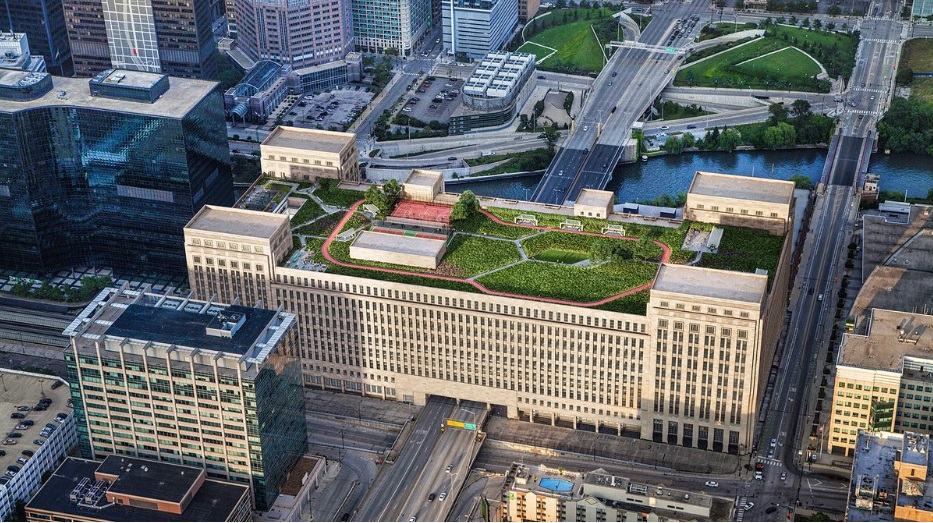 Plan to redevelop Chicago’s historic post office, including a massive green roof.
Plan to redevelop Chicago’s historic post office, including a massive green roof.
Being billed as the largest adaptive reuse project in the nation, the interior work began in early 2017. The current $600 million renovation plan was designed by the Chicago office of global architecture firm Gensler and includes the restoration of the building’s historic lobby as well as redevelopment of a food hall, three-acre rooftop terrace and public riverwalk. The Old Post Office will welcome Walgreens in the fall of 2019, as previously mentioned, whose 200,000-square-foot lease will become home to its IT, digital, mobile, and e-commerce operations as well as the Walgreen’s University training program.
If Amazon were to love the idea of taking up a portion of the Old Post Office, but not into the idea of locating the entirety of HQ2 in a single structure, it could split a campus style development directly across the river. Chicago’s next neighborhood, the 78, is just a stone’s throw away.
The 78
This major riverfront development is located on the South Branch of the Chicago River on a 62-acre parcel of vacant land. It’s referred to as ‘The 78’ because developer Related Midwest anticipates its development of this exceptional, large urban core tract will increase Chicago’s 77 recognized neighborhood areas by one. The 78 has an exceptionally diverse mixed-use plan that includes residential, commercial, academic, civic, cultural, and recreational components. Anchoring a portion of the development will be a new University of Illinois-led public-private research facility known as the Discovery Partners Institute, which will add another major innovation hub to the city’s many others, including the two mentioned above, 1871 and Goose Island, both opposite this site north of downtown.
Lincoln Yards
North of Goose Island is another substantial and unique opportunity for Amazon HQ2, upriver along the North Branch. Almost in sync with Amazon dropping its HQ2 RFP, developer Sterling Bay unveiled plans for Lincoln Yards, to redevelop 70+ riverfront acres located between two of Chicago’s most iconic neighborhoods: Lincoln Park and Bucktown. The site includes a number of parcels assembled for such a master-planned opportunity, but it includes former industrial properties such as the former A. Finkl & Sons steel plant and the city’s former Department of Fleet and Facility Management.  Sterling Bay plan for Lincoln Yards.
Sterling Bay plan for Lincoln Yards.
From a brownfield perspective, however, A. Finkl & Sons is in about as good a condition as you can imagine for a steel plant and metal recycling facility. Years ago, A. Finkl & Sons had the foresight to pour concrete slabs before they began their dirty business. As a result, site prep at Lincoln Yards has enjoyed an accelerated timeline.
At present, the site is slightly transit constrained and vehicle traffic poses an especial risk for bottlenecking. But the developers and city both understand the need for substantial transportation improvements to maximize the opportunity that this ‘last dinosaur’ tract of developable land presents in a historic area of Chicago’s greatest neighborhood tapestry. No similarly scaled opportunity will come to this area any time soon.
So, officials have put a lot on the table, including an extension of the uber popular and elevated 606 bikeway pedestrian trail, mentioned above. Lincoln Yards is also expected to include a new Metra train station east of the Kennedy Expressway, a water taxi stop, road alignments and bus service.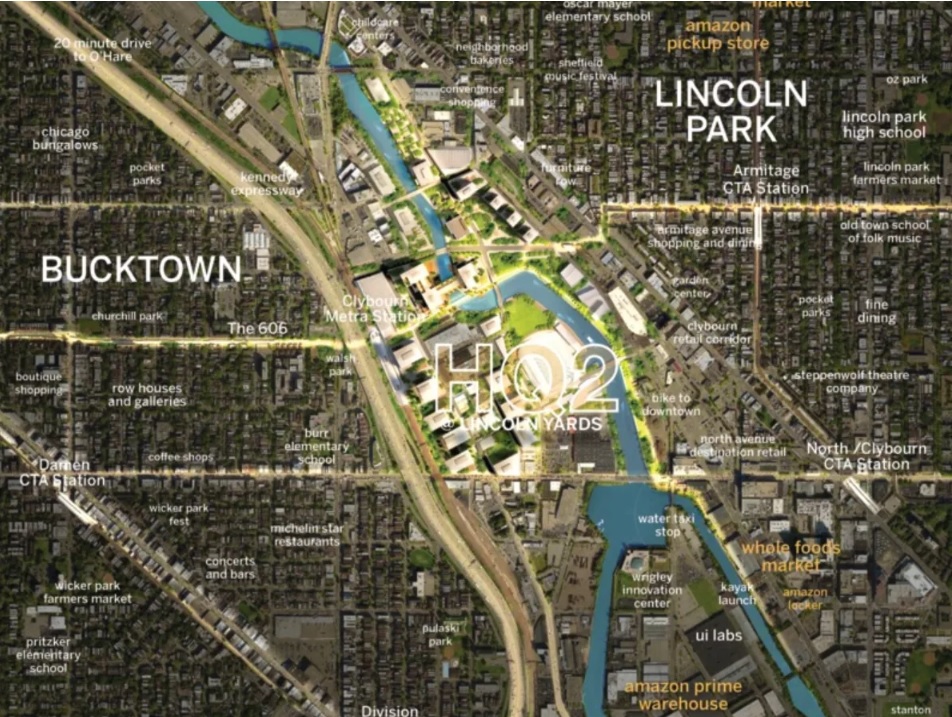
Chicago’s conceptual plan for Lincoln Yards and assets in the nearby neighborhoods.
As one of the premier infill sights in the world, Lincoln Yards is fielding substantial interest. Recently, owner of the World Series Champion, Chicago Cubs Tom Ricketts formed a joint venture with developer Sterling Bay to bring a United Soccer League expansion team to Lincoln Yards. 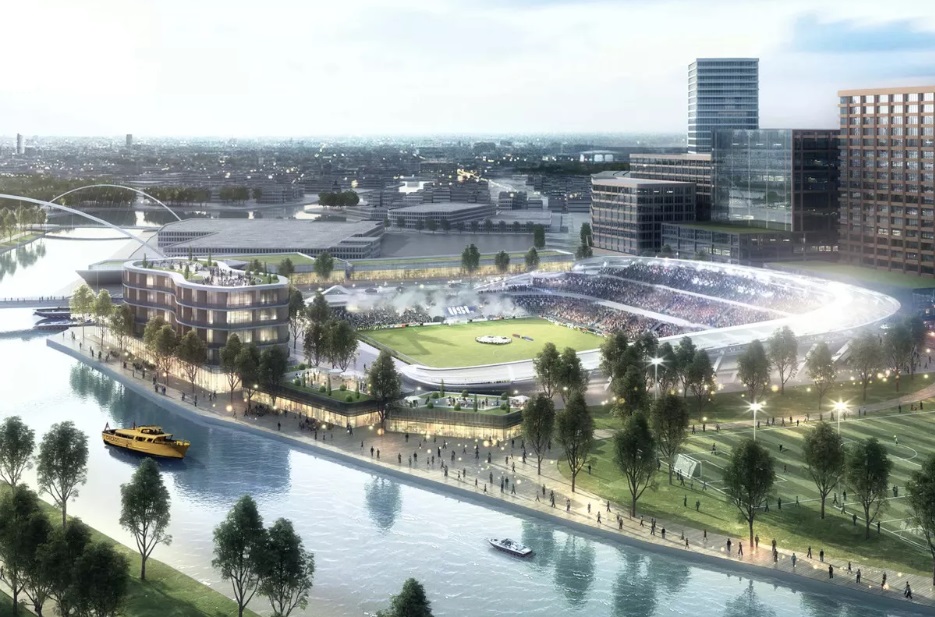 Conceptual plan for stadium at Lincoln Yards.
Conceptual plan for stadium at Lincoln Yards.
Do Chicago’s Negatives Overwhelm its Positives?
Not even close. Chicago gets a bad reputation for its gun violence, but statistically it’s actually a very safe city. Before spiking in the last two years, homicides in Chicago were bouncing along 50 year lows. Overall, crime in Chicago mirrors the national trend, which hovers near generational lows. So, crime just is not the objective strike or competitive disadvantage against Chicago in the site selection process the general public may believe it is.
Some believe that Illinois’ state government down in Springfield is a wet blanket on every city in the state, Chicago included. And in recent years the dysfunction of Illinois government has mirrored that of Washington by finding new lows. The state’s budget stalemate battles have caused deep damage not only to Illinois’ credit rating, but the future potential of its young talent. A study from the Illinois Economic Policy Institute and the Project for Middle Class Renewal at the University of Illinois at Urbana-Champaign suspects that Illinois colleges and universities have 72,000 fewer students as a result of the budget stalemate.
Illinois’ economic and political dysfunction is unfortunate and will be considered by Amazon HQ2’s decision-makers, but none of this has stopped Chicago from dominating corporate investments for five years in a row, as we saw above. Amazon itself has recently invested in eight Illinois warehouses, a new sorting center, and has been expanding its existing Chicago offices in recent years, giving it a larger footprint in Illinois than most anywhere else. And with new Governor and 1871 founder J.B. Pritzker taking over a state government controlled by his own party, expect Illinois’ new administration and state houses to make big moves early on to stabilize the great state of Abraham Lincoln.
So, noise aside, Chicago simply checks off every box on the site selection wish list. It’s a very large, well designed, well maintained urban city with a robust public transit system. Chicago serves as the de facto capital of the North American interior, a global economic leader, transportation hub and world class center of culture cool enough to have won Boeing from Seattle before, allegedly.
Chicago is making the most of the shift towards urbanism and is a city thriving in spite of an underperforming state and larger Rust Belt super region. Its quality of place is ample and diverse and Chicago’s ample land is relatively affordable compared to its coastal competition. It’s crown jewel, however, is it’s incredibly large, talented and diverse workforce and its ability to attract people downtown. The permanent residency of the urban core and surrounding neighborhoods continues to boom. The larger region and state may be shedding some population, but that belies the real story in Chicago.
What Chicago does lack is an incentive package to match some of its competitors, who shot for the moon to start with. In recent weeks, as the HQ2 site selection process draws to a close, competing cities are certainly making their best, if last-ditch pitch to sweeten the deal. Crain’s reported that Mayor Emanuel has spoken directly with Amazon CEO Jeff Bezos regarding HQ2 in recent months.
Chicago surely made its own final sweeteners when Amazon returned for additional visits. The City of Big Shoulders is a finalist, and, objectively, should be. Recent rumors point elsewhere, and to Amazon splitting HQ2 into multiple sites—but Chicagoland has the scale, quality, transit and talent to fit HQ2’s needs and Chicago has enough right size sites in excellent locations to accommodate an Amazon presence split into some of Chicago’s neatest corners.
Each of the 4 potential Chicago sites examined above is located on the riverfront, so a future Amazon water taxi, or air taxi, service could potentially connect offices located at each location with point-to-point transportation as well as Union Station and other river and lakefront destinations.
Why not Columbus?
Columbus is a lot like Chicago, as an over-performing urban area and playing to strengths in this cycle, but it’s no Chicago. Like Austin, Columbus is another smaller state capital city to make the list of HQ2 finalists. It is the most populous city in Ohio with a population of 879,170, making it the 14th-most populous city in nation and the second-most populous city in the Midwest after Chicago. Columbus doesn’t appear to make HQ2’s population threshold, until you consider the greater Columbus MSA, which encompasses ten counties and includes 2,078,725 people—and it’s one of the county’s fastest growing cities.
Situated deep in the heartland like Chicago, Columbus has a dynamism and balance impressive for its smaller size. Columbus is the capital of a swing state, a college town to the third-largest university in the U.S. and major corporate office center all in one. IBM, Battelle, JP Morgan, Facebook and the state-run broadband network operator all have substantial operations in Columbus. Amazon has an expanding presence already too, with as many as 15 Amazon Web services data centers coming to the Columbus area soon.
The retail industry has a particularly strong presence in Columbus, where retailers including L Brands, Abercrombie & Fitch, DSW, The Limited, and Express all operate their headquarters. Columbus’ unique combination of corporate culture, demographics and geography have turned it into the country’s consumer laboratory. Ranking fourth in data compiled by WalletHub microcosms resembling the demographics of the country a whole, Columbus is as American as apple pie.
For residents, living in this retail-centric city of nearly 1 million people can feel like living in a testing ground. As brick-and-mortar retailers struggle to stay relevant, the need to develop new ideas and test solutions is greater than ever. And when a retailer wants to try something new, they usually do it in Columbus.
“We are Test Market, U.S.A.,” Irene Alvarez, director of marketing and communications for Columbus 2020, told the New York Times. “We decide the fate of cheeseburgers and presidents here in Columbus.” Roger Rawlins, chief executive of DSW, the shoe retailer based in Columbus, added: “It’s a perfect melting pot for folks like us to test new concepts.”
Trulia thinks it could be in the top three, ranked high for its housing affordability and accessibility. Ohio’s big incentives are attractive as well, with 35% of payroll taxes totally refunded up to $400 million over 16 years, another 25% of payroll taxes funneled into a special Transit and Mobility fund as well as a 100% property tax abatement.
From Columbus by car, you can reach more than a dozen universities within an hour’s drive. And yet the region has only 140,000 students. Its lower cost of living could be attractive to young talent willing to move to Columbus to help drive innovation for Amazon’s mercantile might into the next generation of Columbus’ great retail legacy.But the city’s built-environment may be unprepared to accommodate such an expansion from its current phase of development. Columbus, for example, is known to lack adequate downtown parking.
Worse, Columbus is the largest city in the country without a transit rail system. There’s a lot of hype behind Hyperloop projects in Columbus, e.g. Hyperloop One plans to connect Chicago, Columbus, and Pittsburgh among its first three routes. Unfortunately, Amazon doesn’t bank on hype and no hyperloop is coming to Columbus on a timeline to matter for HQ2.
While Columbus has plenty of land to support a large campus and pro-development policy that will encourage growth, depending on a dramatic expansion of Columbus’ workforce may be a bridge too far for Amazon. Columbus is also among the less populated HQ2 competitors, with a relatively small labor force. And because talented people are today’s most precious resource for Amazon and all companies today, adequacy of HQ2’s workforce is certainly not a place where it will make a leap of faith.
So, if transit isn’t the HQ2 killer for Columbus, talent probably is. Moreover, given its barely larger than Seattle, the potential that Amazon will recreate its ‘big fish, small pond’ problem in Columbus is particularly high.
Sorry Columbus, but Chicago looks like a much better objective match on paper. Still, no one but Amazon knows for sure. As rumors swirl, a final decision is still pending.
As an objective front-runner and champion of corporate investment 5 years running, Chicago may be the choice Amazon’s head would make. But, as Jeff Bezos said recently, Amazon will be choosing with its heart. As the robust beating heart of the North American interior and unofficial capital of the Midwest’s vast heartland, Chicago still has a chance if Amazon’s heart is choosing. If the history of Seattle companies leaving for Chicago is any guide, however, Chicago won’t find out whether it will be HQ2’s ‘sweet home’ or not until the morning the announcement is made.
So far, we’ve covered 4 of our top 6 objective favorites for Amazon HQ2 going alphabetically. In the next installment of this series, the elimination piece, we’ll really start culling the list and get down to it now that the end of this epic search draws near. Read the last post in this series
